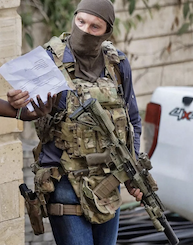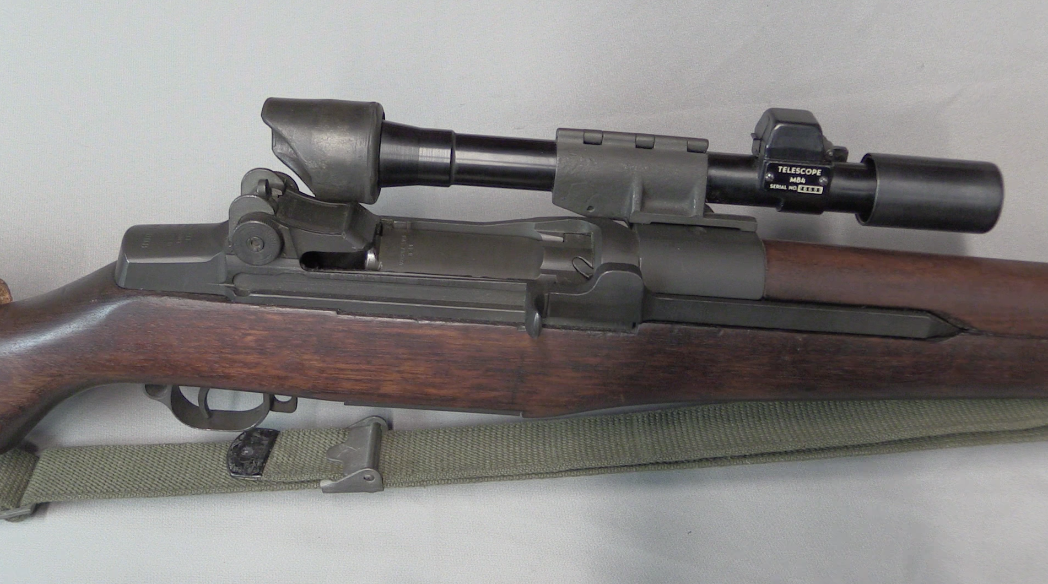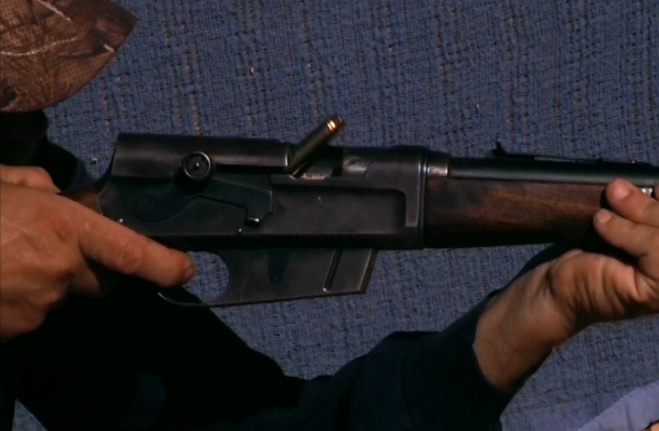Ralf Dieckmann is a German-born firearms designer who grew up as a small child in Berlin during World War II. His interest in firearms developed in the post-war years with war detritus literally lying about in the streets. He emigrated to Canada and enlisted in the Canadian military, where he first designed his P66 pistol. Using that pistol, he found himself work with a series of American gun companies, including Mossberg, Thompson Center, and Ruger (three times!).
Mr. Dieckmann was generous enough to take the time to tell us some of his story, and I found very interesting. I think designers today have a lot to learn from his experiences, and firearms enthusiasts will find his pistol design quite appealing as well.
Also, you may have seen some of his more recent work on the cover of the Collector Grade Publications book “Full Circle”…




Wow – the P66 is a really excellent design, and Mr. Dieckmann seems like a super wonderful fellow.
Agreed. That rimmed cartridge magazine concept is really cool. And as hot as silencers are getting on the commercial market, the appeal of an extra compact length .22 pistol should be all the greater.
I wonder how well semi-rimmed cartridges like the .32 ACP or .38 Super would work with such a magazine system? What could you build around the curved 20 round magazine of the Škorpion?
Hi Brad,
My design is pretty much limited to small diameter cartridges such as 22s.
I designed a .380 ACP version of my pistol, but the magazine capacity was severely limited.
I am not familiar with the Škorpion, but wasn’t that a chechoslovakian sub-machine gun?
Sincerely,
Ralf
“Škorpion, but wasn’t that a chechoslovakian sub-machine gun”
Yes, Škorpion or Samopal Vzor 1961 is Czechoslovak sub-machine gun for .32 Auto: http://modernfirearms.net/smg/chex/skorpion-vz61-e.html
Yes, it is also known as “Cze-cha-cha”. Very popular with competition dancers. 🙂
Man o’ man what a confusion about that small country in centre of Europe. There is another official name for it – Cechia (read Cze-khia). Try it.
Yes. The Czech Skorpion .32 SMG used curved double column magazines, of 10 and 20 rounds capacity.
Mr. Dieckmann, how can one speak with you? Can you email or call a gunsmithing student?
“semi-rimmed cartridges like the .32 ACP ”
For example of .32 Auto high-capacity automatic pistol see CZ-83.
CZ83 is in .380 though.
“CZ83 is in .380 though.”
There exist 9×18 version, .380 Auto version (both with capacity 12) and .32 Auto version (with capacity 15)
http://modernfirearms.net/handguns/hg/chex/cz-82-83-e.html
“CZ83”
And much much earlier and independently from that pistol there was RUBY EXTRA with capacity 22 of .32 Auto cartridges, see 10th image from top here: http://www.carbinesforcollectors.com/llamapage.html
BTW: Now I think that .32 Auto machine pistol might be equivalent (but not equal) to 12 gauge shotgun, but in much smaller package – so far I know military American WW1-era loading of 12 gauge is nine 00 pellet which give mass 9 x 53.8 = 484.2 this is equivalent of 6…7 bullets for .32 Auto (6 x 73 = 438; 7 x 73 = 511). Obviously such weapon would fire bullets one-by-one rather than all-at-one and can’t use special shotgun ammunition (flechette for example) but on the other hand can fire one bullet at a time (if selector present).
Assuming, in favor of .32 Auto, that 6 x .32 Auto is equivalent of 1 x 12 gauge it should be possible to craft automatic pistol sized (or bit larger) weapon with capacity 24 which would be equivalent to 4-shot shotgun. Recoil might be problem, but muzzle brake can help.
First was military version – vz.82 That was built in 9mm Browning equivalent. Then came civilian CZ83 which is in both .32 and .380 calibers.
Remember: vz = military; CZ = civilian and police.
And the Beretta .32 Cheetah, which I think is still produced unlike the great CZ 83.
https://www.youtube.com/watch?v=estGC2nrAE4
.32 isnt conic enough to provide sufficient curvature to the mag.
Excellent interview! And very interesting gun design. Thanks for sharing.
What an amazing life Ralf had. He followed his dream all the way. It if unfortunate at AIG didn’t get the pistol on the market. It was amazing that Browning told him why they couldn’t use his design.
That brings to mind an interesting possibility: by now Ian must have a pretty good set of acquaintances who were involved in firearm design and development in the 1950s 60s and 70s, si perhaps now is the to systematically interview them?
People in industry are typically “anti-enthusiasts”.
They have to be, since viability and marketability of product is what keeps them afloat. In other words, get stuff out of the door, no matter what it is as long as there is a buyer.
From my past experience I remember that maybe 2-3 people out of 120 were personally interested in subject of production. Rest of it was way to get living and management was doing its ‘business planning’ as usual everywhere else. No place for enthusiasm and dreaming.
Mr Dieckmann’s Time with Mossburg Might correspond to the time that they were producing the CAC 45 that you did a . piece on a few years ago. I wonder if he had any inside knowledge of that rare gun?
Yes, that would have been the same period. The small revolver he mentioned would have been the Security Arms, and the large revolver was indeed named the Abilene. Before they were acquired by AIG, Security Arms had been making lookalikes of the S&W Model 60 Chief’s Special. However, they offered it in .357 Magnum, something S&W would not match until more than a decade later.
Hi Bob,
I actually worked on that pistol. My contribution to this already existing design, was the safety. I didn’t like the design with the transverse shaft and the two button-head screws holding the levers in place. I designed the safety as a single piece to be inserted through a slot from the top of the slide. The rear sight was then placed into that slot. I don’t think that design made it to market though.
Sincerely,
Ralf
Great to see you post here! Hope you stay!
Ian, I would be highly interested to know what else Ralf was involved in designing elements of. What other firearms bear his mark? The only other place my google-fu finds him is mentioned in the comments in this thread:
http://weaponsman.com/?p=21799
Where he allegedly had a role in the Ruger Gold Label SxS and a roller-delayed “MP45” …? (this makes me think they are getting him confused with someone … older). Thank you for any information you could provide! I can’t afford a P66, but would love to collect something else of Ralf’s.
The “MP45” mentioned in that post references Dieckmann’s Solidworks illustrations of the Gerät 06H used in Collector Grade Publications’ book “Full Circle.”
Oh, that makes sense! Thank you for the explanation.
Hi Daniel,
That illustration was done in the “Mechanical Desktop”, an earlier solid modelling program by Autodesk. I would love to have access to Solidworks though.
Sincerely,
Ralf
Hi Aono,
I solid modelled the entire Stg 45 a few years ago, working from original Mauser drawings. I did it just for fun, but when a German company found out about it, they made a deal with me to manufacture a semi automatic replica of that rifle. That did not come to pass however, because they got themselves into financial difficulties.
Other fire arms I designed, were Ruger’s Mini-30 and the M-77 Mark 2 Magnum Rifle. As you know, they weren’t new designs but were based on their respective predecessors.
I also designed and built a .50 caliber semi automatic rifle in the 1990s, while I lived in Phoenix. However, that did not progress beyond the prototype stage.
As a gun designer, you are lucky if you get to design a completely new fire arm. Most of your time is spent on product improvement, exploring new materials and testing.
Sincerely,
Ralf
Thank you for that! We do have a Mini-30 in the family, and I’ve always been curious about the Model 77s. As you might have guessed even the most esoteric details are highly interesting to us gun geeks, so I would welcome any design details or anecdotes you might have about them. Thanks again!
So these original stg45 blueprints really exist!!
Is it true that the rifle was never in serial production, and that only existing examples today are replicas made on that blueprints ?
I would really like to hear your story on that, I suppose being from Germany you have easier access to that valuable and rare info.
We need to get as many as possible interviews with older gun designers, ones that started career in 1950-60 (and are now in the very autumn of their life, and many passed away, like for examp. Eugene Stoner) so to preserve that info for future generations
Excellent work as always, Mr. Diekmann’s story is very interesting and I like his pistol. It was very interesting to hear how he actually met and was hired by the men who’s names are on the company, such a rare thing these days. Keep up the good work Ian!!
FWIW: The Dieckmann P66 was profiled in the September/October 1978 issue of American Handgunner. You can read it online here:
http://americanhandgunner.com/1978issues/HSO78.pdf#page=32
Here is the patent for the P66.
https://www.google.com/patents/US3276323
It looks like Dieckmann also had a hand in the design of the Ruger Gold Label shotgun.
https://www.google.com/patents/US5233775
I wonder if the McMillan Group is ever going to release Dieckmann’s .50 BMG rifle. They’ve been playing with it since the late 1990s. I just noticed that a patent was finally granted a couple of years ago.
https://www.google.com/patents/US9046312
Hi Daniel,
Dennis Riordan, who wrote the story in the American Hand Gunner, was my favorite gun writer. He was the only writer who accompanied his writings with an isometric cross section of the particular gun in his stories. He later gave me the original drawings.
There were two additional US patents involved in the P-66:
US 3,608,223 and US 3,713,241.
Sincerely,
Ralf
Hi Ralf,
Thank you for the additional information. Google Patents has a blind spot when it comes to searching for certain patents.
https://www.google.com/patents/US3608223
https://www.google.com/patents/US3713241
I see you even invited public comment on desired features in the January 1965 issue of GUNS Magazine.
http://www.gunsmagazine.com/1965issues/G0165.pdf#page=8
Oh, and I missed another patent reference.
https://www.google.com/patents/USRE26872
The large button at right over the handle seems for the take down and breechbolt looks as taken out from the back. The way of field stripping and similarity of solid, unrecoiling sights with long radius, P66 features rebsmble Ruger Mark l with over advantage of longer barrel with the same gun lenght.
Ralf, it is great to see your story documented. It is a great one.
Thank you for your inspiration and the gift of Small-Arms of the world many years ago.
Hi Mark,
What a good surprise! It is great to hear from you and I know you put that book to good use.
Sincerely,
Ralf
One interesting possibility about Dieckmann’s magazine design is that, if it did become common, if could have been compatible with a 22 rifle as well.
Fine work, what a fascinating life story he’s led, Berlin to Canada to the east coast to the Southwest. Very well done.
Thank you for contacting Ian for the interview Mr. Dieckmann, well said at the end.
Hi Nick,
You are quite welcome.
Sincerely,
Ralf
Ralf you are a really natural storyteller, Ian didn’t have to do much work in this interview. It was fascinating hearing about your life in post war Berlin as a curious child.
I would thoroughly enjoy hearing more about that period and about the other prototype firearms that you mentioned in this interview, from the revolver to the .50 Cal. Or indeed just some general discussion about your time in the industry.
Fascinating interview. I recognize some of the things I’ve run in to in my career as a design engineer:
“not invented here”
“We’ve always done it that way”
“It’s different, It’s wrong”
I’m probably reading more into the situation than I should just from my own experience LOL.
I’ve seen the differential thread method you used on your barrel used to retain the arbor on woodworking shapers. Hey! it works!
I greatly enjoyed the interview of a kindred spirit.
I would not be surprised if Bond Arms might be a company to bring that pistol to fruition. Logically, it would be a wonderful accompaniment to the bullpup pistol design that they picked up from Boburg. I’d rather them, than a company like Kel-Tech.
Beautiful design, simple and elegant.
I sure wish that pistol had made it into production. I would love to have one. Maybe with a little exposure now it could possibly still happen.